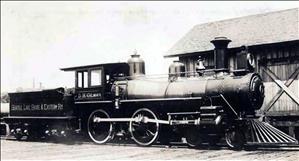The Seattle, Lake Shore & Eastern Railroad Company was incorporated on April 15, 1885, as a solution to the problem of connecting Seattle to the Canadian border. The line was incorporated into the Northern Pacific in 1892. The line's seven-year history reflects the paramount importance of the railroad during the city's formative decades, and the lengths to which early community leaders went to secure a healthy economic future for the fledgling town on the sound.
When Horses Provided Horsepower
In the early days of Seattle's history, when settlers came by wagon or by ship, the prospect of a railroad connection to the East was foremost in the minds of many local developers and city promoters. Transporting freight without railroads was arduous and time consuming, involving horse-drawn carriages and considerable human sweat. Seattle's first industries -- timber and coal production -- involved heavy loads, and quickly underscored the need for railroad lines around Seattle, King County, and the region.
The Northern Pacific tantalized Seattle with the hope that the city would receive a line linking it to the East. But in 1873, the railroad giant opted for a Tacoma terminus. With limited resources, an incensed Seattle built its own railroad, the Seattle & Walla Walla. Before the Seattle, Lake Shore & Eastern Railroad Co. was formed, the Seattle & Walla Walla (which hauled coal from Newcastle to Elliott Bay), was the only local rail line. (The line was purchased in the early 1880s and renamed the Columbia and Puget Sound Railway).
In 1883, Northern Pacific president Henry Villard (1835-1900) raised Seattle's hopes once again with what seemed like support for and interest in local railroad concerns. He visited the city in celebration of the completion of his railroad's transcontinental route across the United States to Tacoma. He built a small line to Stuck Junction (in southern King County) to connect the local Seattle & Walla Walla from Renton (southwest of Lake Washington) to a Northern Pacific line leading to Tacoma. But, a year later Villard was dismissed from the Northern Pacific, and the line became an "orphan road" that was barely maintained.
Once again, the city took into its own hands the problem of railroad construction. Local attorney Thomas Burke (1849-1925), an energetic promoter of city development, took up the charge to create a connection between Seattle and the Canadian Pacific Railway. Upon the suggestion of Daniel H. Gilman, he sought funding from Eastern investors.
In 1884, Burke began his campaign by sending a subscription list to known local investors keen on promoting Seattle's commercial interests. Gilman went East to seek funds, and returned in early 1885. In April, local business leaders founded the Seattle, Lake Shore & Eastern Railroad Company with hopes for yet unobtained funding from the East. The men who formed this company included:
- Judge Thomas Burke
- William Cochrane
- J. W. Currie
- Griffith Davies
- David Denny
- G. M. Haller
- Daniel H. Gilman
- George Kinnear
- John Leary
- J. R. McDonald
- Thomas T. Minor
Capital Gains
In the mid-1880s, Seattle had little money for capital investment. Fundraising efforts initiated by Gilman in 1884 proved successful, but with a small proviso. This stipulation, made by East Coast bankers Jamieson, Smith & Cotting, required a $10,000 investment from the Northwest city.
The bankers agreed to put up the additional $500,000 needed for the railroad. Burke requested and received the $10,000 from Seattle's Angus Mackintosh and Gilman organized a construction company to execute the project. The company would be paid upon the completion of each 10-mile stretch of railroad. Construction raced toward the Snohomish River where the first section would end.
At Cross Purposes
In keeping with the frustrating history of local railroading in the 1870s and 1880s, construction hit a snag at the river crossing. Another railroad originating in Fairhaven (outside of Bellingham, Washington), was seeking a direct and exclusive route from Bellingham Bay to Seattle. The Seattle, Lake Shore & Eastern compromised this imagined monopoly. Eugene Canfield, manager of the Fairhaven company, sought and received an injunction to prevent the Seattle, Lake Shore & Eastern from passing the Snohomish River. According to Clarence Bagley, an early Seattle historian known for enhancing local history, Burke built the bridge despite the injunction by distracting Canfield's men guarding the passage across the river.
Burke, Gilman, and the Puget Sound Construction Company would eventually build many bridges in Western Washington.
The railroad's first depot was constructed in downtown Seattle near the corner of Columbia Street and Western Avenue. Soon thereafter Railroad Avenue was built. This conduit of multiple rail lines occupied an enormous swath of property along Seattle's Elliott Bay waterfront. In the 1950s, Railroad Avenue would become the highway Alaskan Way.
Last Years
By the late 1880s, the Seattle, Lake Shore & Eastern required more funding for ongoing construction toward Sumas, and an extension toward Spokane in Eastern Washington. The Seattle & Eastern Construction Company was formed, with many of the same investors involved in the Puget Sound Construction Company and the Seattle, Lake Shore & Eastern. Construction of the eastern stretch began in Spokane.
In 1892, after a decade and a half of contention between the City of Seattle and the Northern Pacific Railroad, the transcontinental giant absorbed the local railway in an effort to secure control of the Pacific Northwest. This was sparked by competition from the Great Northern Railway and the Union Pacific, and by Seattle's quick growth. Across the country, the largest railroads would buy up the independent rail lines in much the same way.

